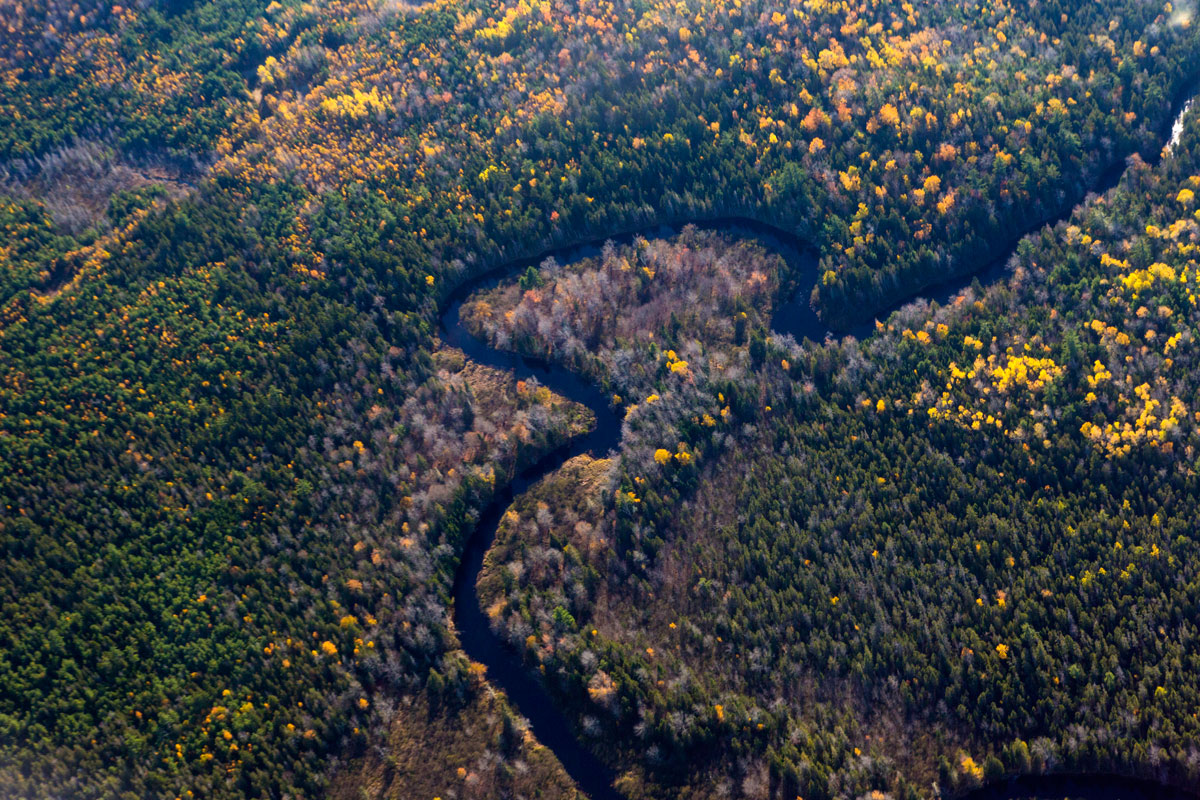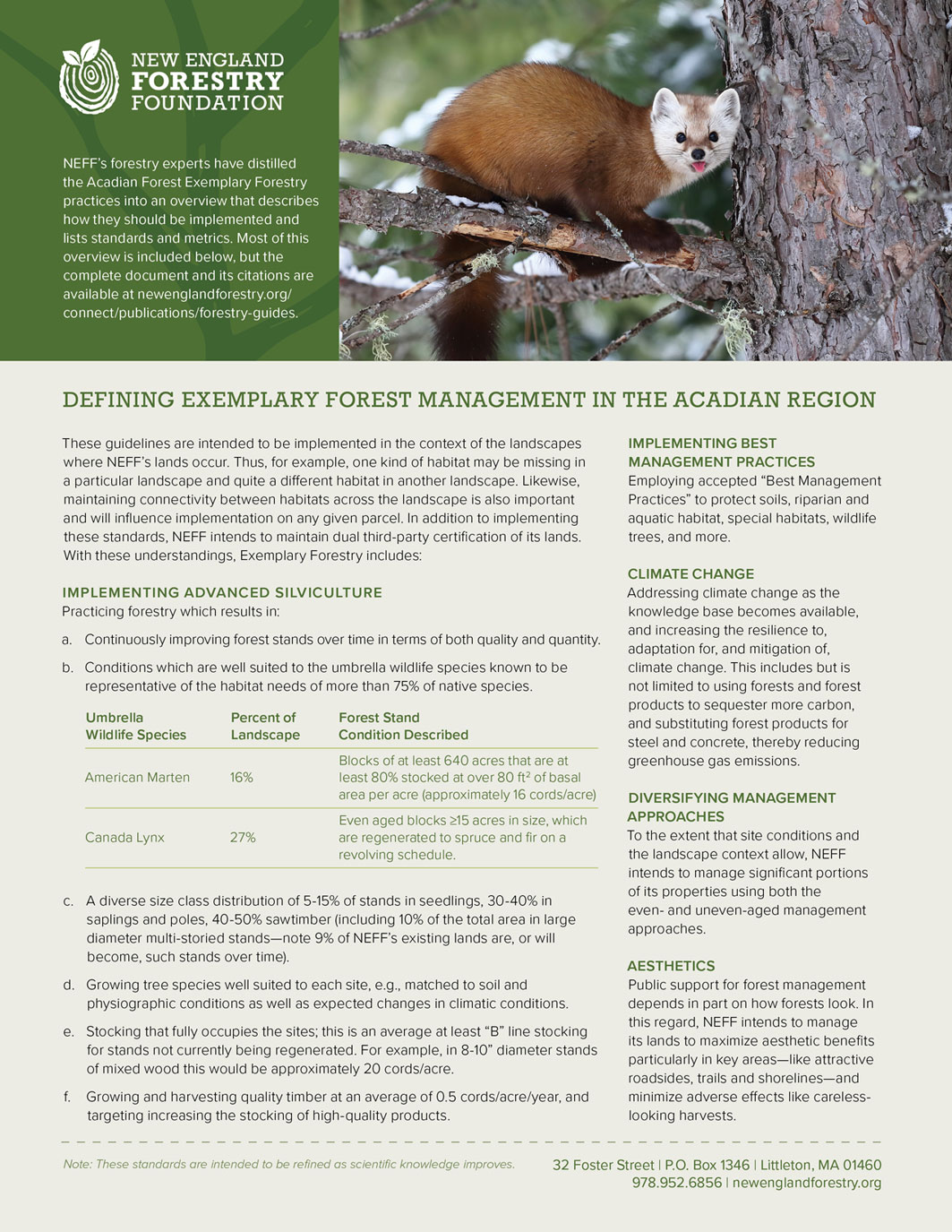Since the New England Forestry Foundation (NEFF) was founded nearly 75 years ago, it has had a twin focus—land conservation and improving forest management. The results of our perspective on forest management are clear: after decades of management and multiple harvests, NEFF’s more than 145 Community Forests have extensive regeneration, large mature trees, and large amounts of wood per acre. NEFF’s forests, in other words, are a living example of what New England forests can do for society—produce products, ecosystem services, and scenic beauty all at the same time.
Over the last few years, NEFF has codified our style of management. The results, called Exemplary Forestry, place the principles that have guided NEFF’s management into a landscape context. The standards call for management that optimizes the productivity of the forest by maintaining high levels of wood growing on the property, and that provides habitat for certain carefully selected species at a landscape scale.
When we fill the habitat needs for these particular animals we know we are also providing habitat for most other species. These target species are called umbrella species. In northern Maine, for example, lynx and marten are the targeted umbrella species, and when we satisfy their habitat needs, we also preserve habitat for 75 percent of the other species in this landscape. In terms of the amount of wood growing on a property, an Exemplary Forestry approach in northern Maine would maintain about 25 cords of wood per acre. Current levels in northwestern Maine average only about 15 cords per acre, and this reduces the amount of carbon stored in the living forest and the productivity of the forest.
Over time, NEFF aims to demonstrate the value of Exemplary Forestry on our own lands and to help other landowners implement these practices. We hope this article helps clarify the benefits and principles of the practice.
Key Goals
In addition to protecting forests and the many ecosystem services they generally provide, Exemplary Forestry is designed to accomplish three goals: improve wildlife habitat, grow more and better-quality wood, and enhance the role forests can play to mitigate climate change.
Exemplary Forestry lays out specific and measurable practices to achieve these goals simultaneously, and documents the scientific basis for the approach and the results we expect to achieve.
Exemplary Forestry in the Acadian Forest
New England has more distinct climate zones than most of western Europe, which means Exemplary Forestry practices need to be tailored to the conditions of particular forest regions. NEFF’s work to date aims to document two sets of management practices, one that is still under development for southern New England and one that is complete for the Acadian Forest region.

Downeast Maine forestlands, photo by Lauren Lambert
NEFF chose to start with the Acadian Forest—a broad band of forestlands that receives steady rainfall and sweeps across northern New England and then up into Canada—both because of the depth of experience NEFF staff has there and because it is home to some of the most extensive commercial forest harvesting in the northeastern U.S.
Alec Giffin, NEFF’s Maine Representative and Senior Advisor and a past director of the Maine Forest Service, has led the project. Alec started with known habitat needs for two wide-ranging species of the Acadian Forest—the American Marten and Canada Lynx. Working with leading forest scientists, Alec led a comparison of those habitats with the needs of other vertebrates native to the region, and then worked with NEFF employee Mike Pounch to analyze the actual habitats that currently exist. The Exemplary Forestry standards are intended to correct the imbalance between needed and existing habitats, and then to maintain the needed habitats into the future. This analysis revealed existing conditions do not match well with the recommendations of forest science. For example, existing stand size-class distributions are deficient in larger diameter stands (see the report mentioned below for details).
Alec and NEFF Executive Director Bob Perschel recently coauthored the project’s final 27-page report, “Exemplary Forestry for the 21st Century: Managing the Acadian Forest for Bird’s Feet and Board Feet at a Landscape Scale.” This was the culmination of a two-year process of research and analysis. Click here to read and download the full report.
Landscape-scale Management
Region-specific standards aren’t the only way Exemplary Forestry ties individual properties to the wider world. It’s designed to balance a parcel’s management with that of other nearby lands both to maximize the property’s impact and in the hopes of creating an entire landscape that meets Exemplary Forestry goals. We view these goals in the context of at least a township in settled portions of New England and several townships in areas of big woods.
This landscape-scale approach to management is part of what sets Exemplary Forestry apart from other forestry methods, and is a particularly important part of protecting ecosystem services and improving wildlife habitat—forests and wild animals are unconcerned with property lines, after all.
Next Steps
The Acadian Forest region encompasses the Downeast Maine forestlands NEFF is currently working to protect, and we are committed to managing them to the high standards set by Exemplary Forestry. These parcels will be among the largest NEFF owns, which means they provide an exciting opportunity to demonstrate Exemplary Forestry at scale to other forest owners.
Downloads and Additional Information
If you’d like to get a feel for the technical details of Exemplary Forestry, NEFF’s forestry experts have distilled the Acadian Forest practices into a one-page overview that describes how they should be implemented and lists landscape-specific standards and metrics. Most of this overview is included in the PDF below, but the complete document and its citations are available here. If you’re unfamiliar with the technical aspects of forestry, a glossary found beneath the PDF may prove useful when reading.
Glossary
NEFF staff provided the italicized definitions, and non-italicized definitions were taken from Thom J. McEvoy’s Introduction to Forest Ecology and Silviculture-Third Edition. Note: Dbh is an abbreviation for “diameter at breast height,” or 4.5 feet above ground.
B-line stocking: The number of trees per acre for any given mean diameter that results in trees having no crown competition, but also no wasted space.
Best Management Practices: Guidelines for how to conduct an activity in an environmentally responsible manner, such as installing drainage control on a forest road. Best management practices are typically defined by state agencies in each state.
Board foot: The surface measure of a cubic volume of lumber that is equivalent to a rough sawn board one inch thick and one square foot in surface area.
Cord: The volume of wood equivalent to that found in firewood stacked 4’x4’x8’, or 128 cubic feet of wood.
Even-aged management: A timber management method that produces a forest or stand composed of trees having relatively small differences in age. The difference in age between trees forming the main canopy level of a stand usually does not exceed 20 percent of the age of the stand at rotation age.
Forest stand: A community of trees occupying a specific area and sufficiently uniform in composition, age, arrangement, and condition as to be distinguishable from the forest on adjacent areas.
Pole timer: A Dbh size class representing trees that are usually more than four inches Dbh but less than ten.
Uneven-aged or all-aged management: A timber management method that produces a stand composed of a wide range of ages and sizes.
Saplings: A user-defined term that generally refers to a tree at least six feet tall but with a Dbh less than five inches.
Sawtimber: Trees that have obtained a minimum Dbh that can be felled and processed into sawlogs.
Seedlings: A user-defined term that generally refers to trees less than 4.5 feet tall.
Silviculture: The art and science of growing forest timber and other values.
Stocking: The amount of wood growing on a given area of land, calculated based on the number of trees per unit area and their combined basal area. Stocking is typically measured as volume per unit of area, for example cords per acre, and is typically used to compare current levels of growing timber on a property to a management goal.
Third-party certification: An official review of management practices on a particular property by an independent body for adherence to standards for sustainability.
Wood quality: Higher-quality timber includes logs suitable for veneer and sawlogs without significant defects like knots. Lower-quality timber includes pulpwood and, at the extreme end, wood suitable only to be used as fuel or ground for mulch.



